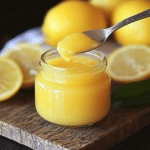Homemade lemon curd is a tangy, sweet, and velvety spread that’s perfect for everything from toast to pastries, and even as a topping for cakes and pies. This luscious curd has a vibrant, fresh lemon flavor that brightens up any dessert. Making lemon curd from scratch is surprisingly easy, and once you taste the fresh, zesty version, you’ll never want to go back to store-bought. Whether you’re looking to enhance your baking or simply enjoy it on a spoon, this homemade lemon curd is a versatile and delicious treat.
Why You’ll Love This Recipe
1. Bright and Refreshing Flavor
With fresh lemon juice and lemon rind, this lemon curd has an unmistakably fresh, tangy flavor that makes it the perfect complement to any dessert.
2. Velvety Texture
The combination of eggs and butter creates a smooth, creamy texture that’s rich and luxurious, making it a delightful spread or filling.
3. Versatile Use
Lemon curd can be used in a variety of ways: as a filling for cakes, tarts, or pastries, spread on toast, or even served with scones or pancakes.
4. Simple Ingredients
This recipe calls for basic pantry ingredients you likely already have, with the main components being fresh lemons, sugar, and eggs. No complicated or hard-to-find ingredients are needed.
5. Quick to Make
Homemade lemon curd takes less than 30 minutes to prepare. In no time, you’ll have a fresh, tangy curd to enhance all your favorite treats.
Ingredients
- Granulated sugar
- Cornstarch
- Salt
- Fresh lemon juice (approximately 5 lemons)
- Large eggs
- Unsalted butter
- Grated lemon rind
Variations
1. Citrus Curd
To change up the flavor, you can mix lemon juice with other citrus fruits like orange or lime juice, creating a citrus medley that gives your curd a unique twist.
2. Lemon Ginger Curd
For a spicy kick, add a teaspoon of freshly grated ginger to the mixture while cooking. This adds a warm, zesty note to the lemon curd, making it a flavorful topping or filling.
3. Herbed Lemon Curd
For a more savory twist, infuse your curd with fresh herbs like thyme or basil while cooking. Strain them out before storing to get a delicate herbal note that pairs wonderfully with desserts or cheeses.
4. Lemon Lavender Curd
Add a teaspoon of culinary lavender while making the curd, then strain it out before using. The floral notes of lavender paired with lemon create a sophisticated curd for special occasions.
How to Make the Recipe
Step 1: Prepare the ingredients
In a medium saucepan, whisk together the granulated sugar, cornstarch, and salt. Add the fresh lemon juice and stir to combine.
Step 2: Heat the mixture
Place the saucepan over medium heat and cook, stirring constantly, until the mixture begins to thicken. This will take around 5-8 minutes. You’ll know it’s ready when it coats the back of a spoon and holds its shape.
Step 3: Add the eggs
In a separate bowl, lightly beat the eggs. Once the lemon mixture has thickened, gradually pour a small amount of the hot mixture into the eggs to temper them (this prevents the eggs from scrambling). Slowly whisk the tempered egg mixture back into the saucepan, stirring constantly.
Step 4: Cook the curd
Continue to cook the curd over medium heat, stirring constantly, until it thickens to your desired consistency. This should take about 5 minutes. Be careful not to overcook it, as the curd may become too thick or curdled.
Step 5: Add butter and lemon rind
Once the curd has thickened, remove it from the heat and stir in the unsalted butter and grated lemon rind. Continue to stir until the butter has melted and the curd is smooth.
Step 6: Strain the curd (optional)
If you prefer a silky-smooth texture, you can strain the curd through a fine-mesh sieve to remove any bits of egg or lemon zest.
Step 7: Cool and store
Let the lemon curd cool to room temperature, then transfer it to an airtight container. Store in the refrigerator for up to 1-2 weeks.
Tips for Making the Recipe
1. Constant Stirring is Key
Make sure to stir the curd constantly while cooking. This prevents the eggs from curdling and helps the mixture thicken evenly.
2. Tempering the Eggs
To avoid cooking the eggs too quickly and ending up with scrambled eggs, always temper them by slowly adding some of the hot lemon mixture before whisking them back into the saucepan.
3. Don’t Overcook
Overcooking lemon curd can cause it to become too thick or curdled. It’s best to remove it from the heat as soon as it reaches a custard-like consistency.
4. Adjust the Sweetness
If you prefer a less sweet curd, you can reduce the amount of sugar by a tablespoon or two. Similarly, if you want it sweeter, feel free to add a bit more sugar.
5. Make Sure Your Lemons Are Fresh
Use fresh lemons for the best flavor. Bottled lemon juice just doesn’t have the same vibrant taste as freshly squeezed juice.
How to Serve
Homemade lemon curd can be used in a variety of ways. Spread it on toast, scones, or muffins for a zesty breakfast treat, or use it as a filling for cakes, tarts, or pastries. It’s also a great addition to yogurt, parfaits, or as a topping for pancakes or waffles. The options are endless for incorporating this bright, tangy curd into your meals and desserts.
Make Ahead and Storage
Storing Leftovers
Once cooled, store your homemade lemon curd in an airtight container in the refrigerator. It will last for up to 1-2 weeks.
Freezing
You can also freeze lemon curd for longer storage. Transfer the cooled curd to a freezer-safe container and freeze for up to 3 months. Thaw overnight in the refrigerator before using.
Reheating
If you need to reheat lemon curd, do so gently over low heat, stirring constantly, until it reaches the desired consistency.
FAQs
1. Can I use bottled lemon juice for this recipe?
For the best flavor, fresh lemon juice is recommended, but bottled lemon juice can be used in a pinch.
2. Can I make lemon curd without eggs?
Eggless lemon curd recipes do exist, typically using cornstarch as a thickener instead of eggs, but the texture will differ from traditional lemon curd.
3. Can I make lemon curd without butter?
Yes, you can make lemon curd without butter. It will still be delicious, though the texture may not be as rich and creamy.
4. How do I know when the curd is done?
The curd is done when it has thickened and coats the back of a spoon. You can also test by running your finger across the back of the spoon—if the line holds, the curd is ready.
5. Can I use lemon curd as a frosting?
Yes, lemon curd works wonderfully as a frosting for cakes and cupcakes, especially when paired with a light buttercream or whipped cream.
6. How do I store lemon curd?
Store lemon curd in an airtight container in the refrigerator for up to 1-2 weeks.
7. Can I freeze lemon curd?
Yes, lemon curd can be frozen for up to 3 months. Thaw it in the refrigerator before using.
8. Can I use lime instead of lemon?
Yes, you can make lime curd using the same recipe, substituting lime juice and zest for the lemon.
9. Can I use a double boiler to make lemon curd?
Yes, using a double boiler to cook the curd is a gentler method and helps prevent the eggs from scrambling, but the stovetop method works just as well if you stir constantly.
10. Can I strain the lemon curd?
Straining the curd is optional, but it helps achieve a smoother texture by removing any bits of zest or cooked egg.
Conclusion
Homemade lemon curd is a delicious, versatile treat that brings a fresh, tangy flavor to all sorts of desserts. Whether you’re spreading it on your morning toast or using it as a filling for cakes, this curd adds a bright pop of citrus that elevates any dish. With just a few simple ingredients and a little patience, you can make your own batch of homemade lemon curd that’s far superior to store-bought. Enjoy the sweet, zesty goodness!
Print
Homemade Lemon Curd
- Total Time: 20-25 minutes
- Yield: Makes approximately 1 ½ cups of lemon curd 1x
Description
This Homemade Lemon Curd is tangy, creamy, and bursting with fresh lemon flavor. It’s perfect for spreading on toast, filling pastries, or simply enjoying by the spoonful. With just a few ingredients, you can create a luscious, silky curd that’s rich in citrus zest.
Ingredients
- 1 cup + 2 tablespoons granulated sugar
- 1 tablespoon cornstarch
- ⅛ teaspoon salt
- 1 cup fresh lemon juice (approximately 5 lemons)
- 3 large eggs
- 2 tablespoons unsalted butter
- 1 teaspoon grated lemon rind
Instructions
- Combine dry ingredients: In a medium saucepan, whisk together the granulated sugar, cornstarch, and salt.
- Add lemon juice: Slowly whisk in the fresh lemon juice, ensuring there are no lumps.
- Cook the mixture: Place the saucepan over medium heat and cook the mixture, stirring constantly. Once it begins to simmer and thicken (about 5-7 minutes), reduce the heat to low.
- Temper the eggs: In a separate bowl, whisk the eggs lightly. Gradually add a small amount of the hot lemon mixture to the eggs while whisking constantly to temper them. Slowly pour the egg mixture back into the saucepan with the remaining lemon mixture, whisking continuously.
- Continue cooking: Return the saucepan to the heat and cook for 2-3 more minutes, stirring constantly, until the mixture thickens to the consistency of pudding.
- Add butter and lemon rind: Remove from the heat and stir in the butter and grated lemon rind until smooth and fully incorporated.
- Cool: Let the lemon curd cool at room temperature or refrigerate it for a firmer texture. Once cooled, transfer to a jar or airtight container.
Notes
- This lemon curd can be stored in the refrigerator for up to 1-2 weeks.
- Use fresh lemon juice for the best flavor.
- To prevent a skin from forming, place a piece of plastic wrap directly on the surface of the curd while it cools.
- Prep Time: 10 minutes
- Cook Time: 10-15 minutes
- Category: Sauce, Dessert, Spread
- Method: Stovetop
- Cuisine: American, British
Keywords: Lemon curd, homemade lemon curd, lemon spread, citrus curd, lemon dessert

